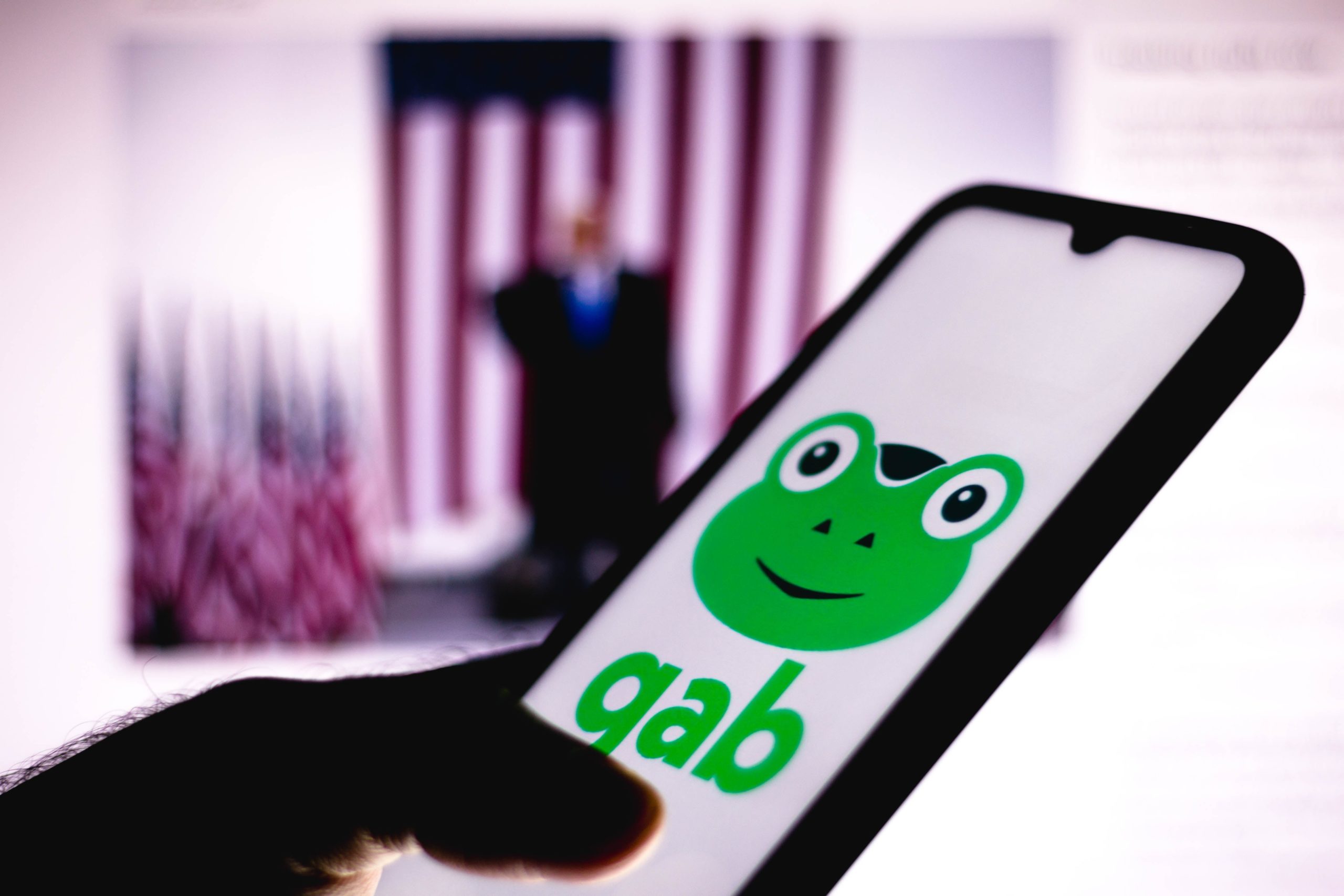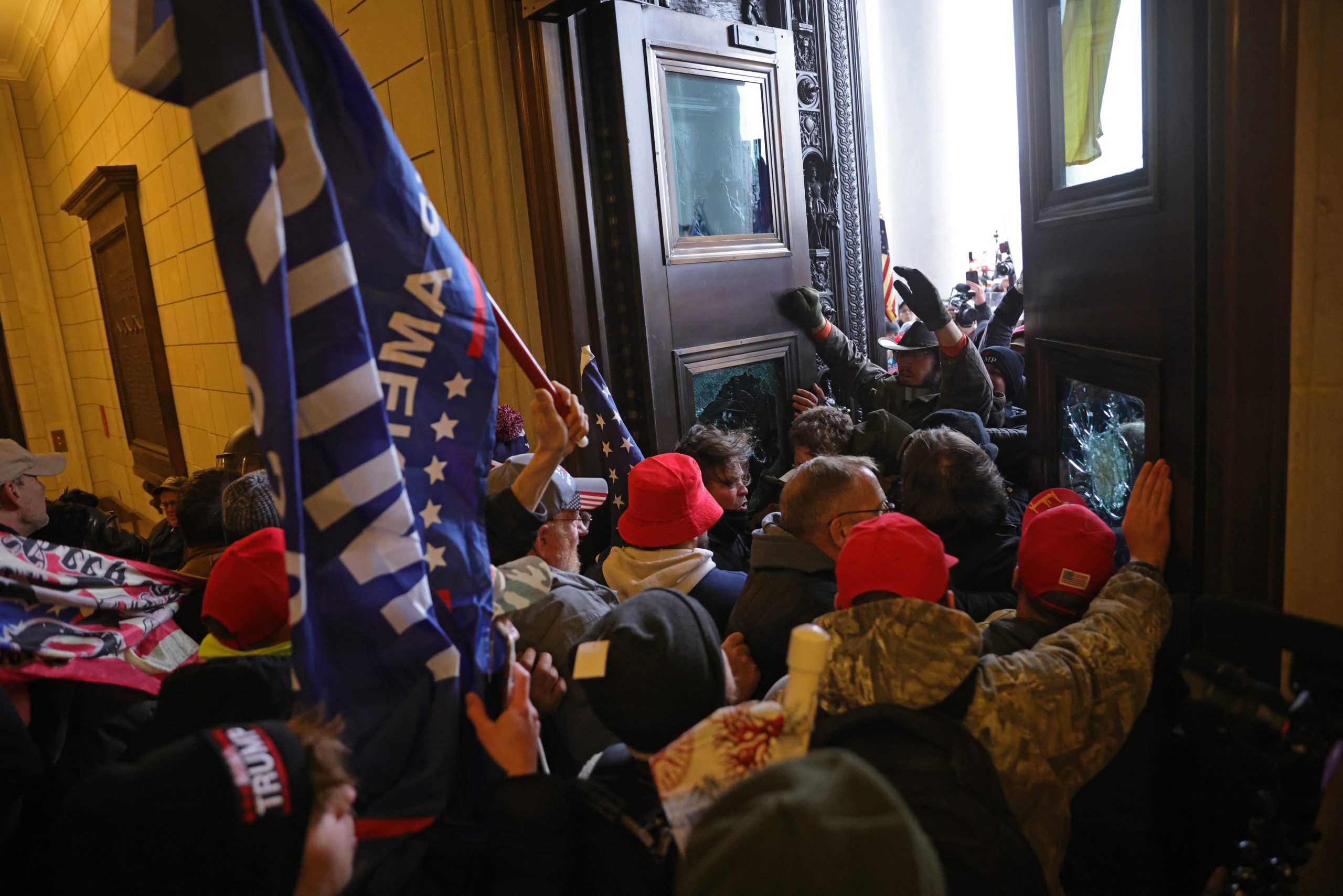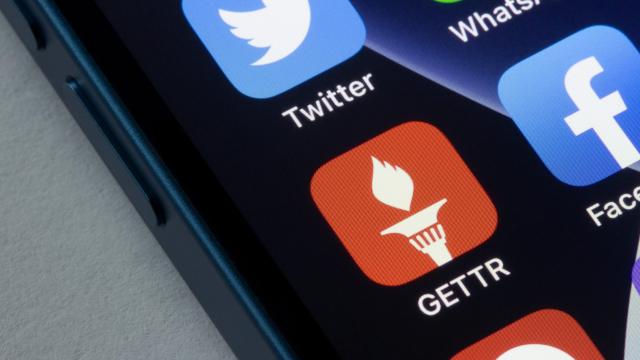It’s now been well over a year since a horde of pro-Donald Trump rioters stormed the U.S. Capitol, trying and failing to return the former president to office. Slowly but surely, the nation has settled into a new normal. So too have the perpetrators’ ideological allies, ranging from the street-brawling Proud Boys to QAnon conspiracy theorists, as well as even more extreme groups like fascists who saw in the riot an opportunity towards further radicalisation.
As 2022 kicks off, here are some of the biggest ongoing trends in online and offline right-wing extremism to keep an eye on.
Switching to alternate web infrastructure

Over the past decade, far-right extremists witnessed firsthand the power of social networks and powerhouse distribution platforms like Facebook, Reddit, YouTube, and Twitter to reach new audiences. But under pressure from politicians, the media, users, and in some cases even their own employees, tech firms flipped. While conspiracy theorists, white supremacists, neo-fascists, and others continue to find large audiences via mainstream platforms, they can no longer rely on them to keep the financial gravy train that funds content creation flowing. They’ve similarly been hounded off of some web infrastructure, ranging from hosting and DNS providers to registrars.
MAGA conservatives have launched their own platforms, like Parler and Gettr, both of which have run into serious operational troubles and are facing a potential knockout blow from the supposedly upcoming launch of Donald Trump’s own site, Truth Social. Those on the more extreme side of the spectrum have changed to alternative web destinations like streaming sites DLive and Odysee, or neo-Nazi hub Gab.
While these so-called “alt-tech” sites have a habit of either failing or struggling to maintain even modest audiences, new ones pop up on a regular basis in a ritual resembling a game of musical chairs. In one example, Nick Fuentes, a white nationalist streamer, recently launched a new streaming site. Several extreme movements, ranging from the Proud Boys to QAnon, have also largely migrated to barely moderated messaging apps like Telegram and other niche web spaces in what has been described as a “great scattering.”
“For example, I noticed today that Infowars is currently advertising 131 different ‘alternative’ places and accounts,” Megan Squire, an Elon University professor and senior fellow at the Southern Poverty Law Centre (SPLC), told Gizmodo.
Disclosure: The author of this story’s partner works for the SPLC, but had no involvement in the writing of this story.
Fashy NFTs

Cryptocurrencies originated as a libertarian-adjacent project intended to free participants in the blockchain economy from government control of their finances. So it’s hardly a surprise that many hardcore Republicans and far-right extremists, suspicious not only of the feds but whether social media companies would cut them off from mass audiences and revenue streams, were early adopters. More recently, they’ve begun to cash in on non-fungible tokens (NFTs). If you don’t know what an NFT is, just understand that it’s a piece of content (usually art) that’s linked on a blockchain and they often sell for wild prices.
Blockchain-themed projects for Trump supporters like the dubious MAGACOIN or NFTs of Trump tweets are abundant. Parler, the aforementioned MAGA site, has announced plans to expand into NFTs. And Steve Bannon is shilling a cryptocurrency called FJB (Fuck Joe Biden).
A study by the Southern Poverty Law Centre found that numerous far-right personalities, ranging from white supremacist and eugenics promoter Stefan Molyneux to neo-Nazi hacker Andrew “Weev” Auernheimer and Daily Stormer founder Andrew Anglin, have likely stockpiled massive returns from the surge in Bitcoin prices in the past few years. NFTs pose yet another opportunity. OpenSea, a web platform that allows users to easily create NFTs, has been widely reported to be saturated with works of art prominently featuring Adolf Hitler. Stonetoss, an anonymous right-wing cartoonist often accused by critics of being an outright fascist, claims to have made nearly $US2 ($3) million on OpenSea and a similar site named Rarible before he was banned.
The far-right is primarily attracted to NFTs as a fundraising method, unlike mainstream crypto promoters who sell it as a long-term investment, according to Squire.
The “reaction to deplatforming extends to finances as well, as of that overall effort to build a parallel replacement economy,” Squire told Gizmodo. “Cryptocurrencies are certainly going to continue to be a piece of that equation, as are extremist-friendly crowdfunding platforms and real-time microfunding or ‘tipping’ sites that they can use to monetise their live video streams.”
The far-right is decentralizing online

In line with those trends, and following debacles like the backlogs of digital evidence produced during the Unite the Right trial over a 2017 hate march in Charlottesville, Virginia, as well as similar evidence and arrests following the Jan. 6 attack on the Capitol, there has been a general push among far-right organisations towards decentralization. For example, the national leadership of the Proud Boys dissolved after the Capitol riot. The group has splintered almost entirely into a number of local chapters across the country, as has their presence on Telegram. According to the New York Times, statistics from the Armed Conflict Location and Event Data Project show that Proud Boys showed up at 145 events in 2021, up from 137 in 2020, reflecting their switch to regional causes like anti-vaxx and anti-mandate protests.
Shannon Hiller, the executive director of the Bridging Divides Initiative, told the Times the data likely understates how many times Proud Boys showed up, as it doesn’t include events like school and health board meetings. She added the trend was concerning, as in 2020 the group mostly mobilized en masse only shortly before the elections.
Similar trends are happening with a number of other groups.
“While the larger social media platforms will continue to struggle with de-platforming extremism, it is likely that the cascade to less regulated affinity-based and encrypted platforms will also continue, overlaying a fractured communication terrain on to an already splintered and polarised electorate,” Professor Brian Levin, a professor of criminal justice at California State University San Bernardino and director of the Centre for the Study of Hate and Extremism, told Gizmodo.
“This cascade across multiple platforms will likely produce increasingly, though not exclusively, a reversion to regionalized low-level conflicts, that may spread, escalate, or be punctuated by violence from cells or loners who radicalize and network online,” Levin added.
Right-wing extremists are running in local elections

The Underpants Gnome strategy of posting constantly, waiting for some kind of conveniently vague miracle to happen, and promptly proclaiming ultimate victory hasn’t worked out so well for pro-Trump election conspiracy theorists or QAnon believers who saw Trump lose the 2020 elections and fail to have the results thrown out. So they’re trying out new strategies.
A recent report by the Atlantic Council’s Digital Forensic Research Lab emphasised that in the wake of the Jan. 6 riots, some far-right groups have refocused on seeking grassroots support in the GOP and building their power upwards — such as by trying to assume control of state and local offices with the power to intervene in future elections and running for school boards. Recall elections against school board officials skyrocketed cross-country and a wave of board members quit throughout 2021 as anti-vaxxers and far-right conspiracy theorists capitalised on widespread anger over school closures.
Many of these efforts intersect with the pedophilia-obsessed QAnon movement, which began attempting to rebrand itself as a legitimate anti-sex trafficking group called “Save the Children” in late 2020. QAnon supporters have been involved in several efforts to undermine election results in local races, such as the hoax Arizona “audit,” and the group’s ranks have been particularly represented in the efforts to take over local offices. QAnon is inextricably tied to Christian extremism, and a prior generation of evangelicals successfully used similar strategies to reshape U.S. politics.
“The precinct strategy, even before it had that name, is a longstanding tactic of gaining influence in politics,” Jared Holt, a resident fellow at the Atlantic Council’s Digital Forensics Research Lab, told Gizmodo. “Proponents of it often correctly assume that obtaining local political positions between a political party and its voters is both easy to do and ripe for asserting influence. The evangelical right was particularly good at doing this for a while.”
“The modern version of this concept is both targeting precinct offices in the Republican Party and local offices like school boards with similar strategies, and leaders in the movement are encouraging those who are successful to use those obtained positions to degrade basic functions of government, like public schooling and election holding,” Holt added.
The U.S. government is still debating how to handle violent extremism

In the wake of the Jan. 6 attack, Joe Biden announced a new national plan to combat domestic terrorism. While the administration took efforts to distinguish its strategy from abuses of power in the War on Terror started by George W. Bush, groups like the ACLU have accused it of promoting new expansions of police authority to surveil, profile, and watchlist citizens that inevitably will be used against activists, protesters, and racial and ethnic minorities.
The Department of Justice recently announced the formation of a new domestic terrorism unit. Despite a nationwide network of joint state-federal intelligence-sharing operations known as fusion centres having received clear heads up of the Jan. 6 riot and doing nothing to prevent it, an idea that gained popularity among some Democrats in Congress and liberal pundits is the idea of passing a national domestic terrorism statute.
Over a year later, and no law has been passed. But Rep. Bennie Thompson has said the House panel investigating the Capitol riots will be recommending new intelligence-gathering legislation, and according to Transactional Records Access Clearinghouse data dating to February 2021 reviewed by In These Times, domestic terror prosecutions have been steadily increasing in recent years. The accused mass shooter who killed four others at Michigan’s Oxford High School in November 2021 has been charged with terrorism, with the Trace reporting critics worry it is setting a precedent towards using anti-terrorism laws for an ever-broadening variety of purposes.
Given the state of things across the U.S. and the certainty of the 2022 midterm elections spurring more toxic rhetoric and radicalisation on the right, don’t count this debate as anywhere near over yet.
So too is the military, but that effort might sputter out

According to the Guardian, of the over 700 persons charged in connection with the Capitol attack, over 80 had ties to the military, and five were acting service members. Meanwhile, the Defence Department has announced new policies intended to root out extremism, prohibiting participation in extremist activities and warning that even Facebook likes of certain content could result in disciplinary action. An Associated Press investigation in late December found that the “new guidelines do not address ongoing disparities in military justice under the Uniform Code of Military Justice, the legal code that governs the U.S. armed forces,” and the U.S. military continues to have no category for hate crimes.
“The infection of extremism into our state and local police and our armed forces is a very serious concern that needs to be monitored,” Paul Eaton, a retired U.S. army major general who wrote an op-ed in the Washington Post warning of the potential for a military coup during the 2024 elections, told the Guardian. “There’s a recruiting effort going on locally, they’re going to school boards, like missionaries sent to the islands to convert people. The Proud Boys and Oath Keepers are definitely recruiting.”
According to Politico, military leaders say that this effort is just ramping up. For example, they have yet to determine how many troops are actually engaged in extremist activities, or develop training for officers to identify white supremacists, anti-government extremists, and fascists in the services. The Pentagon Inspector General has only just begun an audit of screening procedures at enlistment. But the military has insisted that it will tackle the problem for decades and has continually dropped the ball once public attention moves on to other issues, with some experts sceptical that 2022 will finally be the year something changes.
“The past 40 years has basically been a history of some sort of crisis that illustrates extremism in the military and then there’s some sort of patchwork measures taken to try to deal with it,” Mark Pitcavage of the Anti-Defamation League told Politico. He added the new guidelines leave it unclear how extremism will be addressed as “long as it doesn’t specifically advocate the overthrow of the government or violence against people of other races or religions… most white supremacist groups don’t advocate the overthrow of the government.”
Elections will continue to get nastier, with rampant online disinformation going nowhere

Later this year, the 2022 midterms will determine control of Congress and thus Joe Biden’s entire agenda. It will also see a crop of Republican candidates that are determined to win office via stoking the culture-war battles emphasised by Trump, and increasingly extreme gerrymandering and longstanding structural advantages for the GOP in the composition of Congress has them mostly unconcerned with popularity contests.
Given that Republicans broadly closed ranks behind Trump’s fake claims of voter fraud during the 2020 elections, and the party’s base remains very distrustful of the democratic process, the stage is pretty much set for the nastiest midterms in years. It’s reasonable to expect that just as they did during the 2020 elections, platforms like Facebook, Twitter, and YouTube will struggle to deal with rampant falsehoods, claims of voter fraud, and violent rhetoric.
“There’s always going to be this synergistic relationship between the content moderation failures of Facebook, Twitter, and alt tech platforms like Parler,” Candace Rondeaux, executive director of the New America think tank’s Future Frontlines project, told the Hill. “So we should absolutely expect that going into the 2022 midterms, especially in battleground states where things are extremely polarised, we will see a similar dynamic.”
“In past conflictual mid-term and presidential election years we have seen spikes in bigoted, disinformation and extremist content around wedge issues running through and after the election, that in turn often translates to conflict in the real world, like spikes in hate crimes and even homicidal plots,” Levin told Gizmodo.
“An online elastic pool of grievance that has served as a reservoir for conspiracy theories, anti-government sentiment, and bigotry will again morph around hot-button issues, but it will often have an idiosyncratic twist as the information buffet is spread across different platforms,” Levin added.
